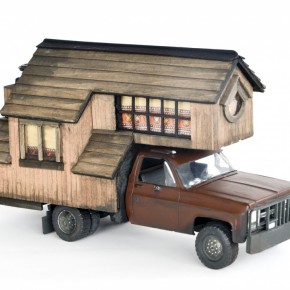The idea of Yellowstone National Park existed in my mind during childhood as Yogi Bear’s Jellystone—the 80’s cartoon paradise in which slow-talking bears sauntered around amidst monochromatic paintbox green trees and creamsicle-coloured skies. When I ventured out to the real Yellowstone on a road trip in my late teens, blaring Crosby Stills Nash & Young from the car speakers, I hoped to experience the great American wilderness. Instead, I drove to my campsite behind a few families in SUVs, who’d pull over at each designated viewpoint hoping to take pictures of elk; I nailed in my tent pegs five feet away from a stranger’s; and I stumbled across several signs directing me to gift shops, toilets, hot showers and canteens—humanity had left its inescapable imprint throughoutthe park.
My expectations of Yellowstone had been too high. I’d conceived of the natural world as something distinct and separate from the human world—a faulty division at best. As environmentalist Bill McKibben famously states, we are living “at the end of nature.” Human activity has permeated the natural world to such a degree that our idealistic notions of where nature ends and we begin no longer hold water. “An idea, a relationship, can go extinct, just like an animal or a plant,” explains McKibben. “The idea in this case is ‘nature,’ the separate and wild province, the world apart from man to which he adapted, under whose rules he was born and died.”
In this issue of Visual Arts News, a handful of artists explore the creation and collapse of boundaries between human-made and natural worlds. Emerging photographer Declan O’Dowd explores the barriers that humans erect between themselves and the wild. O’Dowd’s photographs of Lunenburg County portray curiously decorated fenced-in gardens, designed to keep local deer from devouring produce. Only as Visual Arts News writer Veronica Simmonds learns, local residents often feel penned-in themselves by these constructions of their own design. Halifax-based artist Chris Foster explores our escapist tendencies in his recent travelling exhibition Frontiers in Real Estate. Foster often depicts the mobile home, those traveling temperature-controlled habitats that we rely on when we wish to experience nature, without actually being in it. Ironically, both artists depict humans caught up in almost futile struggles to keep nature at bay, while the actions of our species have already penetrated each and every layer of the globe.
Writer Paul Wapner succinctly characterizes the fusion of the natural and artificial human-made worlds in his book Living Through The End of Nature. “Humans, animals, plants, and machines are now morphing into each other … ” he writes. With irrevocable advances in fields such as biotechnology, nanotechnology and pharmacology, “we are not so much circumscribing nature as splicing ourselves into its very processes …” The human tendency to insert ourselves into the processes of the natural world has long been a source of cultural unease—Mary Shelley issued a grisly warning to the scientific community when she penned Frankenstein, the science fiction novel about the crazed scientist Dr. Frankenstein who created a living creature, known simply as “the monster,” out of composite parts. “I saw the pale student of unhallowed arts kneeling beside the thing he had put together,” writes Shelley in her diary while on a summer tour of Europe in 1816. “I saw the hideous phantasm of a man stretched out, and then, on the working of some powerful engine, show signs of life … Frightful must it be; for supremely frightful would be the effect of any human endeavour to mock the stupendous Creator of the world.”
We often feel a similar sense of unease—the sense that some spiritual boundary has been crossed—when faced with imagery in which the hidden secrets of the body are exposed, dissected and “unnaturally” rearranged. The materials and processes involved in the creation of American artist Pat Hickman’s work, can induce an initial response of repulsion. Hickman’s work, recently on view as part of Dalhousie Art Gallery’s exhibition A Very Long Engagement, breathes new light into once living organic materials, mainly the intestinal lining of hogs. The work literally turns the natural world inside out, forcing viewers to consider the fact that the systems and processes governing their own bodies will one day too collapse. And it is at this moment of realization that the line between ‘us’ and ‘nature’ evaporates, as our tendency to label nature as ‘other’ is prompted largely by a secret desire to outsmart death, a mad denial of our own mortality. But as a second glance at Hickman’s work—delicate and meticulous arrangements of inert matter into hauntingly beautiful wall-hangings and sculptures—its those “monsters” we create when we wish to hold on just a little longer that lend our lives at the threshold of nature and artifice their colour.
















Leave a Reply